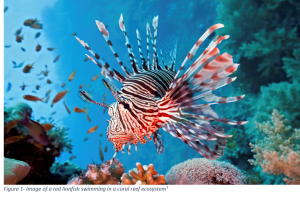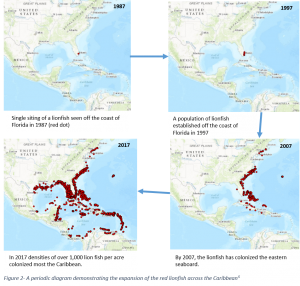Elegant yet destructive, subtle yet menacing. The Lionfish colonization of the Caribbean was a perfect invasion. 
Red Lionfish (Pterois volitans) are a beautiful, elegant fish, yet as the saying goes, “never judge a book by its cover”. Lionfish have invaded and colonized most parts of the Caribbean with the species spreading so fast that researchers and marine biologists are worried about the future of the Caribbean ecosystem.
What are invasive species?
Invasive species are known to cause extinctions of species and reduction in ecosystem biodiversity as they often outcompete other species in their newly invaded ecosystems². An invasive species is a species not originally from an ecosystem causing economic or environmental harm with potential harm to human health³. Invasive species are often unintended hitchhikers on cargo ships being carried around the world in ballast water and in shipped goods. Over the past few years, lionfish have become the poster child for invasive species in the Atlantic Ocean, receiving as much attention as zebra mussels and Asian carp⁴.
Why are lionfish in the Caribbean?
Native to the Pacific and Indian ocean, the red lionfish were first seen in the Caribbean in the late 1980s and now have spread all throughout the Caribbean as seen in the image below. These bewitchingly beautiful fish come armed with highly venomous spines, having very few natural predators, a perfect facilitator for a successful invasion. Lionfish continue to spread through the Caribbean (as seen in figure 2⁵) due to very fortunate characteristics of being very resilient to large temperature variations and biologically resistant to most diseases and parasites⁶.

How are invasive species affecting ecosystems?
Coral reefs are amongst the most diverse ecosystems on earth with all parts of this ecosystem dependent on one another from life cycles of organisms to biological structure and function of organisms. Invasive species often disturb functioning habitats by eating juvenile fish⁹, reducing fish populations and disturbing the balances of reef ecosystems and essentially modifying the ecosystems¹⁰. This is what happened with the lionfish resulting in concern from researchers and marine biologists to the long-term future of the reefs with a change in the ecosystem structure and function.
Invasive species often can carry disease with them having massive effects on organisms living in the ecosystem. Organisms living within the ecosystem may be vulnerable to new disease, reducing the organisms chance of survival. An example of this is the Dutch Elm disease being introduced into America and Europe resulting in the rotting of tree roots and starving the tree of nutrition.
Why are lionfish damaging?
Lionfish feast upon juvenile fish and small crustaceans around coral reefs, with research identifying that a single lionfish residing on a patch of coral reef can reduce recruitment of juvenile fish by 79%, greatly reducing fish biodiversity⁴ ⁷. The lionfish’s’ prey is essential in reducing toxic algae that poison and suffocate the coral reefs, which without reduce the growth of corals⁴. The expansion of lionfish put additional stress on coral reefs already stressed by climate change, pollution, acidification, disease and overfishing⁸.
[500words]
References
1 – Clark, C., 2015. Lionfish study explores idea of eating an ecological problem. Available at: https://phys.org/news/2015-11-lionfish-explores-idea-ecological-problem.html. Last accessed on 12th March 2017.
2 – Clavero Pineda, M. and García-Berthou, E., 2005. Invasive species are a leading cause of animal extinctions. Trends in Ecology and Evolution.
3 – Mooney, H.A. and Hobbs, R.J. eds., 2000. Invasive species in a changing world (Vol. 23). Washington, DC: Island Press.
4 – NOAA., 2014. Invasive Lionfish Threaten Coral Reefs and Fisheries. NOAA Fisheries. Available at: http://www.nmfs.noaa.gov/stories/2014/12/12_01_14impacts_of_invasive_lionfish.html. Last accessed on 14th March 2017.
5 – USGS., 2017. Nonindigenous Aquatic Species. Available at: https://nas.er.usgs.gov/queries/SpeciesAnimatedMap.aspx?speciesID=963. Last accessed on 20th March 2017.
6 – Morris Jr, J.A. and Whitfield, P.E., 2009. Biology, ecology, control and management of the invasive Indo-Pacific lionfish: an updated integrated assessment.
7 – Albins, M.A. and Hixon, M.A., 2008. Invasive Indo-Pacific lionfish Pterois volitans reduce recruitment of Atlantic coral-reef fishes. Marine Ecology Progress Series, 367, pp.233-238.
8 – Goldberg, J. and Wilkinson, C., 2004. Global threats to coral reefs: coral bleaching, global climate change, disease, predator plagues and invasive species. Status of coral reefs of the world, 2004, pp.67-92.
9 – Guy, A., 2016. Facing a Plague of Invasive Lionfish, Caribbean and Gulf Communities Get Creative. Oceana. Available at: http://oceana.org/blog/facing-plague-invasive-lionfish-caribbean-and-gulf-communities-get-creative. Last accessed on 19th March 2017.
10 – Green, S.J., Akins, J.L., Maljković, A. and Côté, I.M., 2012. Invasive lionfish drive Atlantic coral reef fish declines. PloS one, 7(3).
Recent Comments